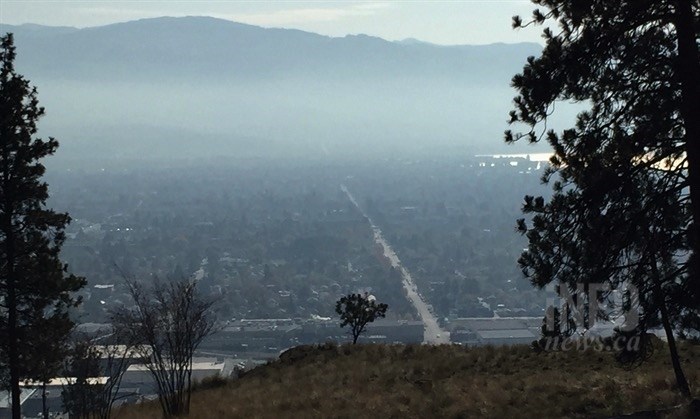
This view from Kelowna's Knox Mountain on Tuesday, Oct. 23, 2018 shows haze blocking out the view of the south slopes.
(ROB MUNRO / iNFOnews.ca)
October 23, 2018 - 6:00 PM
KELOWNA - Okanagan residents can be forgiven if they look out their windows and think they’re back to the smoky days of summer.
But the haze hanging over some hillsides is not due to forest fires. And don’t blame orchardists for burning their prunings because that and all other open burning has been prohibited since Oct. 14.
“With all the fog and humidity, it makes it look worse than it is,” Environment Canada meteorologist Doug Lundquist told iNFOnews.ca. “We’re under a stagnant air situation with high pressure over us. The good news is that it’s going to break down soon.”
The Air Quality Index for Penticton and Kelowna is 2, or good. Vernon is at 3. Still good but moving up the 10-point air quality scale.
In order to have open burning anywhere in B.C. certain conditions have to be met, including an air venting index of 55. That means there must be enough wind and the right type of wind to lift smoke into the atmosphere. The wrong kind of wind would simply blow smoke into someone else’s backyard.
In the Central Okanagan – the only Okanagan regional district with an air quality co-ordinator - the standards are tougher. The venting index has to be 65 and the particulate matter index also has to be below 15 (the full explanation of what these scales mean is quite technical).
So, where is the smoke coming from?
“It is hazy,” said Nancy Mora, the Central Okanagan’s air quality co-ordinator. “I could be several sources. It could be just vehicles. And, we have a lot of wood burning appliances, which produce 30 per cent of the particulate matter in the air.”
The provincial government estimates there are between 4,000 and 12,000 wood burning appliances in the Central Okanagan. The range is so broad that Mora is working to get a better handle on that aspect of local air pollution.
A study was completed in 2016 by driving repeatedly along certain Central Okanagan roads and taking particulate matter readings.
“Hot spots” were most concentrated along Rutland Road but there were others along Highway 97 in West Kelowna, Kelowna and Lake Country and along Okaview.
But that’s just a snapshot.
The Central Okanagan has a wood stove exchange program with rebates of $250 to $400 to upgrade. There’s a budget to do about 50 exchanges a year, Mohr said, but only half a dozen people have taken advantage of it.
There’s also a free chipping program for farm waste, but it’s limited to about $80,000 a year so there is a waiting list. Mohr said it could cost up to five times as much annually to chip all orchard wastes.
For those who can’t take advantage of that program, they can get 80 per cent of their chipping costs back, to a maximum of $500, if they chip themselves.
The Okanagan-Similkameen Regional District says they will pay 75 per cent of the cost of grinding agriculture waste in Penticton, Oliver, Keremeos and surrounding rural areas. It also encourages farmers and orchardists to contact them about the proper way to package ground cover plastic, plastic pipes and netting so it can be accepted at landfills for free.
The Regional District of the North Okanagan has nothing on its webpage about burning or air quality. Mora said there has not been an air quality co-ordinator in the North Okanagan since she arrived in Kelowna in 2013 and none in the Okanagan Similkameen since 2015.
That may be unfortunate for North Okanagan residents since the air quality there is generally poorer than the rest of the valley, Lundquist said. Penticton tends to be at the windier end of the valley while there’s less wind in the north and, therefore, poorer air quality.
Mora is trying to do more to improve the valley’s air quality.
She hopes to take a report to her board late in November or early in January with about 20 recommendations to improve air quality, dealing with everything from dust to campfires to agricultural burning.
One thing she would like to do is follow Montreal’s example and have all wood burning appliances registered within three years along with an exchange program to upgrade or replace them. She expects a round of public consultations to be held before any actions are implemented.
To contact a reporter for this story, email Rob Munro or call 250-808-0143 or email the editor. You can also submit photos, videos or news tips to the newsroom and be entered to win a monthly prize draw.
We welcome your comments and opinions on our stories but play nice. We won't censor or delete comments unless they contain off-topic statements or links, unnecessary vulgarity, false facts, spam or obviously fake profiles. If you have any concerns about what you see in comments, email the editor in the link above.
News from © iNFOnews, 2018